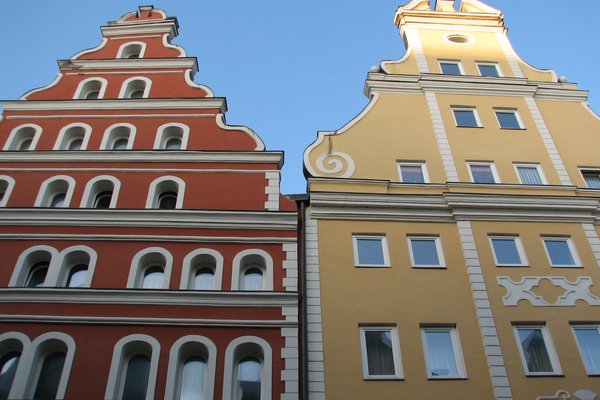Germany
Stralsund and Wismar
The Historic Centres of Stralsund and Wismar represent Hanseatic trading towns and influential examples of brick construction.
The two coastal cities were the leading centers of the Wendish section of the Hanseatic League from the 13th to the 15th centuries. Several churches and residential and commercial buildings were built in fired brick in the elaborate architectural style of Brick Gothic. In the 17th and 18th centuries, the cities were fortified and further developed under Swedish rule.
Community Perspective: The medieval townscape has been well-preserved in these two smallish cities. The main highlights of both are the gothic red-brick churches.
Site Info
Official Information
- Full Name
- Historic Centres of Stralsund and Wismar (ID: 1067)
- Country
- Germany
- Status
-
Inscribed 2002
Site history
History of Stralsund and Wismar
- 2002: Inscribed
- Inscribed
- Type
- Cultural
- Criteria
- ii
- iv
Links
- UNESCO
- whc.unesco.org
- Official
-
- wismar-stralsund.de — Two cities - one heritage
All Links
UNESCO.org
- whc.unesco.org — whc.unesco.org/
Official Website
- wismar-stralsund.de — Two cities - one heritage
Community Information
- Community Category
- Urban landscape: Maritime
Travel Information
Recent Connections
-
Perfect Inscriptions
2002 -
Seven Years' War
The Blockade of Stralsund occurred duri… -
Depicted in Mizielinska Maps
Astronomical clock in St. Nicholas Chur…
Connections of Stralsund and Wismar
- Geography
- Trivia
-
-
Built or owned by Swedes
Wismar (1632- 1803)and Stralsund (1653-1815) -
Once the tallest freestanding structure in the World
St. Mary's church: 1549-1569, 1573-1647 (151 m) (If Tallinn is counted, then only 1625-1647) -
Cultural sites taking up an entire island
Stralsund: "Unique in Stralsund is the island location, unchanged since the 13th century, between the Strelasund and the ponds on the land side, which were dammed soon after the town was founded." -
Built or owned by Dutch
The Wasserkunst in Wismar was designed by the Dutch architect Philipp Brandin. -
Depicted in Mizielinska Maps
Astronomical clock in St. Nicholas ChurchSee i.pinimg.com
-
Twin Towns
-
- History
-
-
Seven Years' War
The Blockade of Stralsund occurred during the Seven Years' War when a Prussian force invested the Swedish garrison of Stralsund, the capital of Swedish Pomerania.. Sweden had entered the Seven Years' War in 1757, joining France, Russia, Austria and Saxony in their alliance against the Prussians. (wiki)See en.wikipedia.org
-
Hanseatic League
"leading centers of the Wendish section of the Hanseatic League from the 13th to 15th centuries" (OUV)
-
- Architecture
- Damaged
-
-
Damaged in World War II
Wismar - " The 80 m high tower church of St Mary ( Marienkirche) is the only remainder of the original Brick Gothic edifice, built in the first half of the 13th century. It suffered heavy damage in World War II, and was deliberately destroyed in 1960 under the E German Communist government." (wiki)
-
- World Heritage Process
-
-
Perfect Inscriptions
2002 -
Recommended for combination by AB
With Lübeck: "ICOMOS further recommends that consideration be given to the possibility of inscribing the historic towns of Stralsund and Wismar as a serial nomination together with Lübeck. All three towns were leading centres in the Wendish region of the Hanseatic League in northern Germany" -
Extended from original TWHS
Originally only Old Market - Stralsund at GDR's Tentative List
-
- Religion and Belief
-
-
Dominican Order
Schwarzes Kloster (Wismar)See de.wikipedia.org
-
Franciscan Order
Franciscan monasteries at both Stralsund and Wismar -
Nunneries
Kloster St. Annen und Brigitten in Stralsund -
Augustinian Order
Kloster St. Annen und Brigitten in Stralsund -
Religious sites connected to fishermen
Wismar's St. Nicholas Church was once the church of the fishermen, sailors and travelers.
-
- Human Activity
- Constructions
-
-
Historic Pharmacies
Ratsapotheke at StralsundSee de.wikipedia.org
-
Canals
The "Grube" in Wismar is "the last artificial mediaeval waterway to be preserved in an old city in Northern Germany" (Nom File) -
Hospitals
Hospital zum heiligen Geist at Stralsund -
Astronomical clocks
From 14th century in St. Nicholas Church, StralsundSee de.wikipedia.org
-
- WHS on Other Lists
-
-
European Route of Brick Gothic
-
European Museum of the Year Award
Ozeaneum Stralsund, Stralsund (2010)
-
- Timeline
-
-
Built in the 13th century
Wismar and Stralsund, leading centres of the Wendish section of the Hanseatic League from the 13th to 15th centuries (AB ev)
-
- WHS Hotspots
- Science and Technology
-
-
Libraries
Baroque library at St. John monastery
-
- WHS Names
-
-
Once named after Stalin
L?bsche Stra?e , the main street of Wismar , was called "Stalinstra?e"
-
- Literature & Film
-
-
Location for a classic movie
the 1922 version of Nosfaratu ("One of the silent era's most influential masterpieces") is set and filmed in WismarSee en.wikipedia.org
-
News
No news.
Recent Visitors
Visitors of Stralsund and Wismar
- Adrian Turtschi
- Alexander Barabanov
- Alexander Lehmann
- A. Mehmet Haksever
- Ammon Watkins
- Ana Lozano
- Anna Wludarska
- Argo
- ArnaudFilloux
- Artur Anuszewski
- AS
- Ask Gudmundsen
- Aspasia
- Assif
- Astraftis
- a.thum
- Atila Ege
- AYB
- Bamse
- BaziFettehenne
- Bill Maurmann
- Bin
- Birgitte Sørensen
- Bram de Bruin
- Brendan Carroll
- Bropyk
- c82wc1
- Can SARICA
- Carlos Sotelo
- Caspar
- Cezar Grozavu
- Cheryl
- CherylKla
- Chole Ross
- Christer Sundberg
- Christian Wagner
- christof
- Christoph
- Christravelblog
- Claire Bradshaw
- Clyde
- Colossus
- Csaba Nováczky
- ctravel
- CugelVance
- Dagmara
- Daniela Hohmann
- Daniel Chazad
- Daniel Gabi
- Danieljbromberg
- Dan Pettigrew
- David Berlanda
- Dimitar Krastev
- Dimitrios Polychronopoulos
- Dirk-pieter
- Don Irwin
- Dorejd
- Echwel
- Elia Vettorato
- Ellen Nielsen
- Els Slots
- erdsaumnaht
- Errol Neo
- Eva Kisgyorgy
- Evgenii
- fabi-ddorf
- Fan Yibo
- Farinelli
- Federico P.
- Feldhase
- Filip Murlak
- FK
- Flexiear
- Frederik Dawson
- FS
- Galgalula
- Gary Arndt
- George Gdanski
- GeorgeIng61
- GerhardM
- Gernot
- Harald T.
- Harry Mitsidis
- henrik_hannfors
- heywhatever2
- Hubert
- Iain Jackson
- Ian Cade
- Ingemar Eriksson
- Ingrid
- Ivan Rucek
- Jaakkotoivanen
- Jacob Choi
- Jacob Otten
- Jakob F.
- Janina Lehmann
- Janos
- Jan Zimmermann
- Jarek Pokrzywnicki
- Jasam
- Javier Coro
- Jean Lecaillon
- Jens
- Jezza
- JobStopar
- Joel on the Road
- John Smaranda
- Jonas Hagung
- Jonas Kremer
- Jonas Martinsson
- Joyce van Soest
- KarenBMoore
- Kasia M.
- Kasper
- Kbecq
- Ken DJ
- Kerékgyártó
- Knut
- Kristin
- Krzysztof B
- Kurt Lauer
- Lara Adler
- lichia
- Lisu Marian
- Lithobates
- Loic Pedras
- Luboang
- Lucio
- Luis Filipe Gaspar
- Lukasz Palczewski
- Maciej Gil
- Maciej Gowin
- Malgorzata Kopczynska
- Małgosia Łupicka
- Manuelfunk
- Martin
- Martina Rúčková
- Matejicek
- MaxHeAnouBen
- MaYumin
- MH
- Michaela0705
- Michael Ayers
- Michael Novins
- michaelsballard
- Michael Turtle
- Mikko
- Mikko Syrjä
- Miloš Tašković
- miri2808
- MMM
- Nafis N
- nan
- Nasebaer
- Nicole Lampos
- Nihal Ege
- PabloNorte
- Patrik
- Patrik_globe
- Paul Schofield
- PeterA
- PeterH
- Peter Lööv
- Petteri
- Philipp Leu
- Philipp Peterer
- Piotr Wasil
- PlacesWeHaveBeenTo
- Potsdamer
- Purrfect
- Rafał Kałczuga
- Ralf Regele
- Randi Thomsen
- Reisedachs
- Reza
- Rick Ohm
- RobRos
- Rodinia
- Roger Enarsson
- Roger Ourset
- Roman Bruehwiler
- Roman Raab
- Ronbon
- Rudegirl
- Sabrina Liebehentschel
- Sandmann15
- Schnitzel
- Sebasfhb
- Sehnsuchtsbummler
- serghei.belous
- Sergio Arjona
- Shandos Cleaver
- Shijie ZHU
- Simonh
- SirLoydd
- Solivagant
- Stanislaw Warwas
- Stefan Loov
- Svein Elias
- Szabolcs Mosonyi
- Szucs Tamas
- Tamara Ratz
- Taotao Chen
- Tcchang0825
- Thomas Buechler
- Thomas van der Walt
- Thorben
- Timonator
- Tom Flaten
- tony0001
- triath
- Truls Brekke
- Tsunami
- usagi1974
- Valentina
- Vanessa Buechler
- Veronica
- VLabhard
- WalGra
- Westwards
- WILLIAM RICH
- Wojciech Fedoruk
- Wo_ko
- Xiquinho Silva
- YaroMir
- Yevhen Ivanovych
- Zoë Sheng
- Zos M
Community Reviews
Show full reviews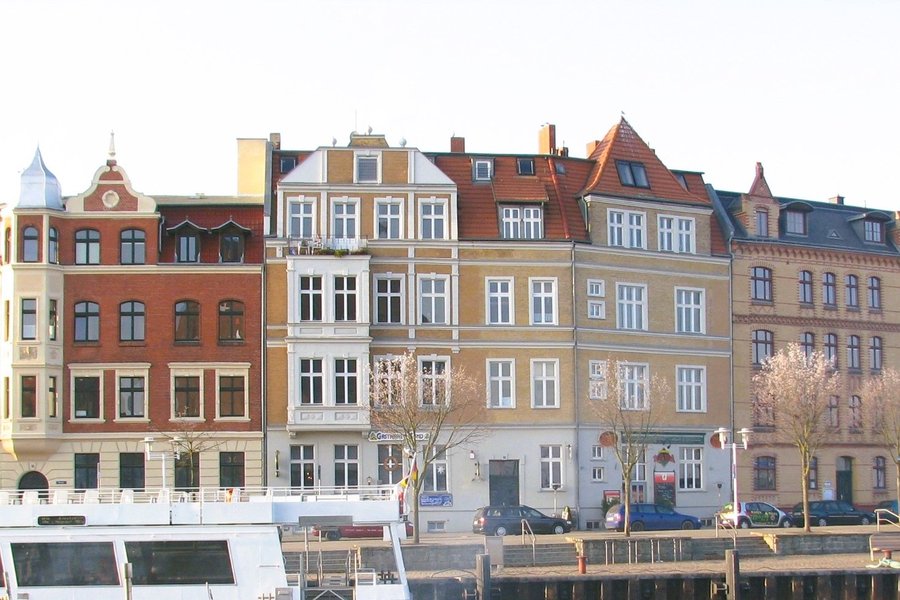
I visited Wismar and Stralsund during a two-week trip around northeastern Germany in October 2023. In both cities I stayed one and a half or two days to see its sights but also to soak in the atmosphere. They are good cities for a world heritage traveler insofar as they have enough to offer to keep you entertained for a couple of days but they are also small enough that after those days you feel you have seen them decently enough. Beside the highlights in both towns, it is a great pleasure to walk around the streets and watch out for remarkable buildings of which I generally like the old gabled merchants houses the best and both cities have a lot of those to offer. But when you walk the streets it is also rather painful how many wounds there are. How much was destroyed, mainly in WW2, but also how much was lost by neglect and lack of money and how much is still endangered despite the great renovation efforts since the reunification of Germany. Wismar has several highlights that are not to miss: Brick gothic was probably the biggest thrill on this trip and the St Nikolai church in Wismar may be the best of the churches in both towns. It is an impressive building and the second tallest brick gothic after the Marienkirche in Lübeck (the latter could easily a WHS site by itself). In addition, it features several remarkable art works: a medieval baptismal font made …
Keep reading 0 comments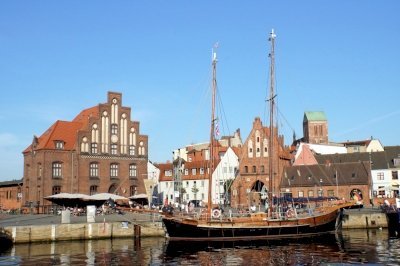
There are good reasons why these two Hanseatic towns were inscribed together as one World Heritage Site. They have a lot in common: a similar medieval layout, churches in Brick Gothic architecture as their main landmarks, well-preserved gabled houses dating from the time of the Hanseatic League and traces from the period of Swedish rule.In 2002, when Stralsund and Wismar were inscribed, the Hanseatic League was already well represented on the WH list. And even Germany had a similar WHS with Lübeck, inscribed as early as 1987. So, nothing outstanding about Stralsund and Wismar? Indeed, if you have already visited other Hanseatic towns, Riga for example, you may feel that this WHS has nothing to offer that you have not seen elsewhere, and probably even better. Lübeck has the Holstentor, but neither Stralsund nor Wismar have such a distinctive and unique building. On a positive note: the medieval townscape has largely been preserved in both cities, there are hardly any ugly modern additions. Again, Lübeck as a counterexample.
The old town of Stralsund is located on an island. From the tower of St. Mary's Church, you have a beautiful view of the historic town center, the sea and the island of Rügen.The best moment in Stralsund was a coffee in the sun on the Old Market Square with a view to the façade of the Town Hall and the towers of the St. Nikolas’ Church, and the gabled houses in my back.
In Wismar there is also a …
Keep reading 0 comments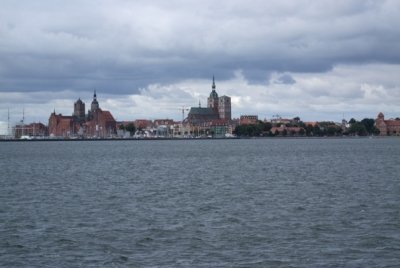
Stralsund is a town of the brick gothic, the style that I like. Well, it is quite common in Northern Europe, and I could see it already in Riga, Roskilde, Brandenburg, Stendal, Tangermunde, Brugges, even in Bavarian Landshut, etc… but the examples I found in Stralsund belong to the finest ones of the style, and Stralsund reminds me the old town of Riga.
Stralsund is perfectly preserved, so, there are 3 large brick churches (Our Lady – open for free, St Nicolas – deconsecrated museum that I refused to visit, and St Jacob – closed for renovations in time of my visit), one very representative brick Municipal Hall (a beautiful text-book structure), the brick hospital church, and numerous brick town houses, which I enjoyed maybe the most. However, my highlight was Our Lady church built in the radical gothic style that can be seen on windows on the eastern side that are virtually cut in the middle by corners, which is modern or almost timeless rather than gothic feature.
I spent a couple of days in Stralsund during my trip to Rugen Island some 5 years ago. I went by direct train from Prague, and I was not disappointed. Besides Rugen, I also went to the small island of Hiddensee by ferry, highly recommended if you are there. PHOTO – the view from the ferry towards Stralsund (St Nicola in the middle, Municipal Hall on the right, and on the left there are towers of St. Jacob and …
Keep reading 0 comments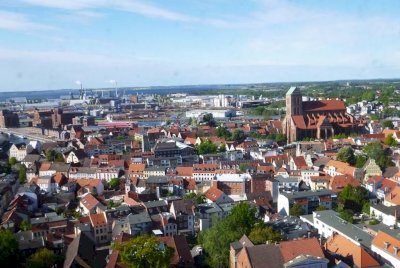
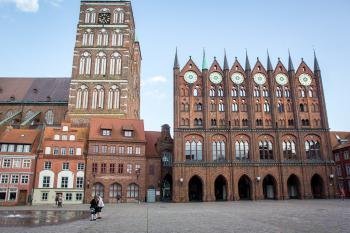
Hundreds of years after the Hanseatic League lost its influence, both Stralsund and Wismar became major administrative and defence centres when they were ruled by the Swedish kingdom in the 17th and 18th centuries. The need for protection means both city centres stayed relatively small and concentrated. That’s great for visitors because it’s easy to walk between the main sights and explore most significant buildings within a day.
Even if there wasn’t the history and the medieval architecture, Stralsund and Wismar are interesting cities to visit. The influences of the Baltic coast means there’s a recreational feel lots of great seafood and bars on offer. I buy a pickled herring sandwich from a man in Wismar who is serving them right off a boat in the harbour.
You can see the main sights of either in less than a day but an overnight stay is a great way to experience a bit more and enjoy the calmer evenings when the tourist buses leave and the sunset drinks start getting poured.
Keep reading 0 comments
In Stralsund, I got a strong impression when I walked along the city wall of Knieperwall how big is Stralsund. There are also two beautiful gates; Kutertor and Kniepertor. The most beautiful building of Stralsund is Rathaus because of an architectural language. That identified as the Gothic of the region of Sund. This city has a lots of Swedish influence especially colors and style at houses. Building restoration is still under process in the historic center of Stralsund. The lookout from the tower of St Marien church is so beautiful ! Wismar is much smaller than Stralsund. The Bridge House, canal Grube, Furstenhof, St Mary's Church, Alter Schwede and Wasserkunst are my favorite attractions of Wismar. St Mary's Church is a landmark of Wismar because of the 80 metre high tower. The Furstenhof is the earliest important Renaissance structure in Mecklenburg. Stralsund and Wismar have both own World Heritage Information Center. The entrance to these center is free!
Keep reading 0 comments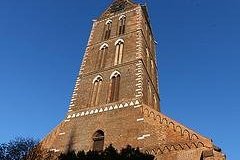
I visited this WHS in October 2014. Unfortunately I only had time to visit Wismar as I wanted to visit nearby Schwerin and also go birdwatching since hundreds of grey cranes were arriving after migration. I spent a whole day wandering around the narrow streets of Wismar, admiring the gable houses next to the red brick houses. The market square and the Wasserkunst is worth visiting as is the Bridge House and the harbour area. The main highlights of Wismar are the 3 gothic red brick churches: St Nicholas Church (worth visiting inside to view the beautiful genealogical tree fresco and the intricate triptych dating from 1430), St George's Church and St. Mary's Church (only the tower is left). Having viewed 3 out of the 6 churches I think I can safely say that I could grasp the OUV of this WHS. If ever I will have the chance to visit Stralsund, further north in Mecklenburg Vorpommern, I'll happily visit. Otherwise, I'll treasure the wonderful day I spent in Wismar.
Keep reading 0 comments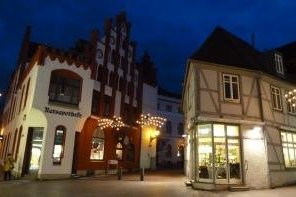
Well I will give those Baltic Red-Brick Gothic architects’ one thing: they can certainly build a massive church. That was the main thing that struck me after my visit to Wismar on New Year’s Eve 2012/13.
My exploration took me through the affluent looking shopping streets from the heaving bulk of one massive church onto the next, and wandering through the giant remnants of St Marien Kirche. It was rather impressive. I can’t say I was particularly taken by the main square, much like Frederik my main impression was one of a giant car park surrounded by a few nice buildings. On my way towards the old Harbour I stopped into the Heiligengeistkirche as residents were arriving for Mass. I was really impressed by the painted ceiling and also thankful of somewhere to warm up.
As it was New Years eve I spent a lot of my time jumping at the sound of fireworks exploding next to me, but also covered an inordinate amount of miles trying to find an open restaurant or bar, they were all reserved for private parties later in the night, but after 20 or so establishments, I managed to have a pizza down by the waterfront (In case you are wondering I’m not exaggerating, even the Irish Pub was closed!), however the harbour side was a rather charming place to while away some time before heading off to my train.
Wismar was a late addition to my itinerary, it was there in part because of …
Keep reading 0 comments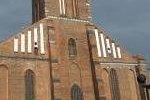
After visiting Wismar and Stralsund as well as Lubeck this year, I am pleased that Lubeck is a separate WHS. Probably as a result of having been hidden in East Germany for several decades these two towns have retained their integrity as heritage towns. Very little modern construction is apparent, in fact some WWII bomb damage is yet to be restored, eg the Marienkirche in Wismar).
Saw both towns in a day, travelling by train between.
Keep reading 0 comments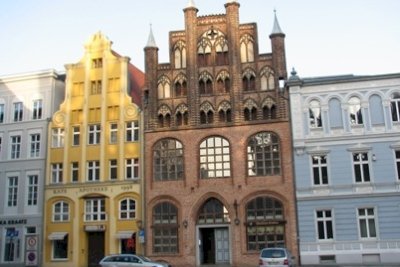
Both Stralsund and Wismar can be visited on a day trip from any of northern Germany's big cities. I choose the more remote Stralsund, located about 200 km east of Lübeck. It's an easy Autobahn ride deep into Mecklenburg-Vorpommern and close to the German-Polish border where controls were lifted earlier this week. How the world changes. Stralsund itself used to be hidden behind the Iron Curtain too.
Anno 2007 it turns out to be a pretty and well-looked-after little town. Parking and navigation is easy in the almost deserted streets. Ugly modern construction that so dominates Lübeck fortunately is lacking here. The Hanseatic and the Swedish heritage go side-by-side, brick houses and colourful residences alternate in the streets. The most impressive sights are the red brick churches adorned with huge towers.
One of these former churches now houses the 'Meeresmuseum', a museum dedicated to the sea with bits and pieces of GDR history and an aquarium. Fun for kids and a bit quirky too.
The Stralsund harbour is where the locals are taking their Sunday stroll. I finish my stay here at a fish restaurant with lunch of jacked potato and caviar.
Keep reading 0 comments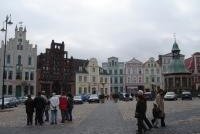
Wismar is a small town on the Baltic coast in northern Germany which has rich heritage of Hanseatic League and Sweden. Wismar can be called a prettiest small city in northern Germany; it's full of many lovely buildings from Hanseatic brick style to Swedish gable houses. Its pride is large red brick cathedral of St. Nikolai which every decorative detail made from bricks, a very unique way in this region. The city's market square is very nice with lovely, renovated building and in the center of the square is a big well covered with Dutch Renaissance style pavilion called Wasserkunst! The seafront area is also nice with lively old buildings and fish market.
The big problem of Wismar is cars, they park everywhere from main square to small streets which sometime ruins the atmosphere. Waking in Wismar is a very nice experience; all pavements are very good in design for walking, every turns always have some surprise with amazing buildings, churches, squares and my favorite is a bridge decorated with pigs! Wismar is just great for spending your time in holiday, less crowned compared to Stralsund or Lubeck and has the feel of down to earth. Swedish link is still active in this city; I can see Swedish flags more than German ones. You may wonder where you are now, Sweden or Germany.
Keep reading 0 comments
